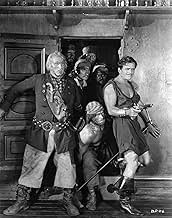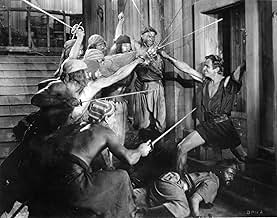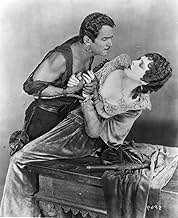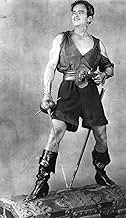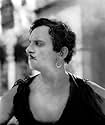CALIFICACIÓN DE IMDb
7.0/10
2.3 k
TU CALIFICACIÓN
Agrega una trama en tu idiomaSeeking revenge, an athletic young man joins the pirate band responsible for his father's death.Seeking revenge, an athletic young man joins the pirate band responsible for his father's death.Seeking revenge, an athletic young man joins the pirate band responsible for his father's death.
- Dirección
- Guionistas
- Elenco
- Premios
- 3 premios ganados en total
Douglas Fairbanks
- The Duke of Arnoldo
- (as Mr. Douglas Fairbanks)
- …
Billie Dove
- Princess Isobel
- (as Miss Billie Dove)
Tempe Pigott
- Duenna
- (as Miss Tempé Pigett)
Donald Crisp
- MacTavish
- (as Mr. Donald Crisp)
Sam De Grasse
- Pirate Lieutenant
- (as Mr. Sam de Grasse)
Anders Randolf
- Pirate Captain
- (as Mr. Anders Randolf)
Charles Stevens
- Powder Man
- (as Mr.Charles Stevens)
John Wallace
- Peg-Leg Pirate
- (as Mr. John Wallace)
Fred Becker
- Pirate
- (as Mr. Fred Becker)
Charles Belcher
- Chief Passenger - Nobleman
- (as Mr. Charles Belcher)
E.J. Ratcliffe
- The Governor
- (as Mr. E. J. Ratcliffe)
Jimmy Dime
- Pirate
- (sin créditos)
George Holt
- Pirate
- (sin créditos)
Dave Kashner
- Pirate
- (sin créditos)
Stubby Kruger
- Pirate
- (sin créditos)
Charles Lewis
- Pirate
- (sin créditos)
Barry Norton
- Youth
- (sin créditos)
- Dirección
- Guionistas
- Todo el elenco y el equipo
- Producción, taquilla y más en IMDbPro
Opiniones destacadas
I first heard about this film from my father, who once told me that he saw it as a boy when it first came out and was completely blown away by it. I only recently had the opportunity to see it myself, and I can appreciate his point. Of course it's absurd to compare the production values of an antique movie such as this to modern films, but just see it and try to imagine how it must have seemed to audiences at the Roxy back in 1926!
Needless to say, this elaborate, full-color production is merely a showcase for the incomparable Douglas Fairbanks. Errol Flynn, Tyrone Power, Sean Connery and Harrison Ford pale to insignificance beside Fairbank's bravura on-screen personality. Fairbanks virtually invented the "action-adventure" movie, and films like "The Black Pirate" make it clear why he was the biggest movie star of his time.
In addition, bear in mind that there were no stunt men or blue-screen special effects back then. Fairbanks actually DID all those amazing stunts himself! The only latter-day Hollywood star who would (and did) dare to do his own stunts was the equally incomparable Burt Lancaster.
Don't expect modern acting or sensibilities in The Black Pirate, the movie itself is typical 1920s melodrama. The sets are pretty hokey and the plot is absurd. However, just ignore all that while you sit back and enjoy Douglas Fairbanks delivering one of the most spectacular performances ever captured on screen.
Needless to say, this elaborate, full-color production is merely a showcase for the incomparable Douglas Fairbanks. Errol Flynn, Tyrone Power, Sean Connery and Harrison Ford pale to insignificance beside Fairbank's bravura on-screen personality. Fairbanks virtually invented the "action-adventure" movie, and films like "The Black Pirate" make it clear why he was the biggest movie star of his time.
In addition, bear in mind that there were no stunt men or blue-screen special effects back then. Fairbanks actually DID all those amazing stunts himself! The only latter-day Hollywood star who would (and did) dare to do his own stunts was the equally incomparable Burt Lancaster.
Don't expect modern acting or sensibilities in The Black Pirate, the movie itself is typical 1920s melodrama. The sets are pretty hokey and the plot is absurd. However, just ignore all that while you sit back and enjoy Douglas Fairbanks delivering one of the most spectacular performances ever captured on screen.
A nobleman vows vengeance on the cutthroats responsible for his father's death. Becoming THE BLACK PIRATE, he joins their scurvy crew and quickly becomes their leader. But his plans for revenge become more complicated when he meets his first captive - a beautiful Spanish princess.
Roistering, robust & richly detailed, this was one of Douglas Fairbanks' greatest films. With enough excitement to satisfy any lover of adventure, one needs only read the film's prologue to get an idea of its delights: 'A page from the History and Lives of the most Bloodthirsty PIRATES who ever infested THE SOUTHERN SEAS. Being an account of BUCCANEERS & the Spanish MAIN, the Jolly Roger, Golden Galleons, bleached skulls, BURIED TREASURE, the Plank, dirks & cutlasses, SCUTTLED SHIPS, marooning, DESPERATE DEEDS, DESPERATE MEN, and - even on this dark soil - ROMANCE.' Aside from the bleached skulls, everything else is there as promised
Fairbanks is a joy to behold, exulting in his physical prowess, becoming a legend of the screen before the delighted eyes of the viewer. Can any other swashbuckler top the flair or élan of the sequence where Doug captures a merchantman single-handed, climbing up the forecastle & sliding down the slit sails on his dagger, light as any sprite? No one else would have even dared.
As the princess, Billie Dove is beautiful, but has very little to do except look frightened. Donald Crisp, in a change of pace role, is very enjoyable as a gruff one-armed Scots pirate who befriends Fairbanks. Anders Randolf & Sam De Grasse are the black-hearted pirate captain & lieutenant whom Doug must contend with and they are nasty indeed.
A milestone in cinematic history, this was one of the first movies to be filmed entirely in Technicolor. In its restored version, it is very pleasant to the eyes, its antique hues perfectly complementing the richly textured art design, costumes & sets.
For those interested in such things, there are explanations for the various special effects (the underwater attack, for instance), but the reader will need to look elsewhere for them. Sometimes too many facts can spoil the illusion of daydreams so necessary for the enjoyment of silent cinema. Find this fabulous film & dream on.
Too bad about the bleached skulls, though...
Roistering, robust & richly detailed, this was one of Douglas Fairbanks' greatest films. With enough excitement to satisfy any lover of adventure, one needs only read the film's prologue to get an idea of its delights: 'A page from the History and Lives of the most Bloodthirsty PIRATES who ever infested THE SOUTHERN SEAS. Being an account of BUCCANEERS & the Spanish MAIN, the Jolly Roger, Golden Galleons, bleached skulls, BURIED TREASURE, the Plank, dirks & cutlasses, SCUTTLED SHIPS, marooning, DESPERATE DEEDS, DESPERATE MEN, and - even on this dark soil - ROMANCE.' Aside from the bleached skulls, everything else is there as promised
Fairbanks is a joy to behold, exulting in his physical prowess, becoming a legend of the screen before the delighted eyes of the viewer. Can any other swashbuckler top the flair or élan of the sequence where Doug captures a merchantman single-handed, climbing up the forecastle & sliding down the slit sails on his dagger, light as any sprite? No one else would have even dared.
As the princess, Billie Dove is beautiful, but has very little to do except look frightened. Donald Crisp, in a change of pace role, is very enjoyable as a gruff one-armed Scots pirate who befriends Fairbanks. Anders Randolf & Sam De Grasse are the black-hearted pirate captain & lieutenant whom Doug must contend with and they are nasty indeed.
A milestone in cinematic history, this was one of the first movies to be filmed entirely in Technicolor. In its restored version, it is very pleasant to the eyes, its antique hues perfectly complementing the richly textured art design, costumes & sets.
For those interested in such things, there are explanations for the various special effects (the underwater attack, for instance), but the reader will need to look elsewhere for them. Sometimes too many facts can spoil the illusion of daydreams so necessary for the enjoyment of silent cinema. Find this fabulous film & dream on.
Too bad about the bleached skulls, though...
Douglas Fairbanks Sr. stars in this exciting, action-packed swashbuckling pirate adventure yarn, as a young man seeking revenge on a band of pirates after they ransacked and destroyed his ship, killing his father. In trying to achieve his goal, he tricks the pirates into thinking he wants to join their band. Will this ruse work?
This delivers all the thrills and cutthroat pirate action anyone could ever hope for and even more. It has all the elements one looks for and wants from today's big blockbusters: impressive stunts mostly performed by Fairbanks himself, sword fights, pirate treachery, explosions, daring underwater scenes, a damsel in distress, the works. There's a few plot holes and questionable plot twists here and there but it all holds up incredibly well after all these years although in today's world lead actress Billie Dove would have been given more to do. That's a minor nitpick at best. If you like pirate yarns, check this out. Believe me, they just don't get much better than this.
This delivers all the thrills and cutthroat pirate action anyone could ever hope for and even more. It has all the elements one looks for and wants from today's big blockbusters: impressive stunts mostly performed by Fairbanks himself, sword fights, pirate treachery, explosions, daring underwater scenes, a damsel in distress, the works. There's a few plot holes and questionable plot twists here and there but it all holds up incredibly well after all these years although in today's world lead actress Billie Dove would have been given more to do. That's a minor nitpick at best. If you like pirate yarns, check this out. Believe me, they just don't get much better than this.
This was an excellent pirate movie and was better than many sound pirate films. However, it's really hard to rate the movie---compared to other silent pirate films, it might just be the best. But, compared to THE SEA HAWK, CAPTAIN BLOOD or THE BLACK SWAN (all wonderful sound pirate films from the 30s and 40s), it isn't as good a film.
So what does the movie do that worked so well for me? First, being a Douglas Fairbanks film, it had wonderful stunts and impeccable production values--something he was known for in his silent films. Second, this film had excellent sets and was the best film money could buy in its day. In fact, it was such a lavish production that it was supposedly the first full-length film made in 2-color Technicolor--an early and somewhat crude way of producing a color movie. Because the film was dyed with green-blue and orange-red dyes, the film mostly looks reddish-green--definitely NOT true color. But, it doesn't look that bad--certainly much better than the horrid colorized films destroyed in the 1980s. Plus, if it hadn't been for films like this, the infinitely better 3-color system might never have been developed by Technicolor. And, finally, the plot is pretty good for a silent film--not the most complex when compared to later films, it's not nearly as simplistic as most other silents.
This video was produced by KINO FILMS. Some of their silent films in the past were less than wonderful (especially some of their Buster Keaton videotapes), but this videotape is top quality and has nice extras at the end of the tape. Some cheaper prints apparently are only black and white, not color. Nice job for the restoration, KINO! However, despite what the video box said, it was apparently NOT the first full-length two-color Technicolor film. I recently saw a restored print from TOLL OF THE SEA (1922) and it was in fact made using this process four years earlier than THE BLACK PIRATE.
So what does the movie do that worked so well for me? First, being a Douglas Fairbanks film, it had wonderful stunts and impeccable production values--something he was known for in his silent films. Second, this film had excellent sets and was the best film money could buy in its day. In fact, it was such a lavish production that it was supposedly the first full-length film made in 2-color Technicolor--an early and somewhat crude way of producing a color movie. Because the film was dyed with green-blue and orange-red dyes, the film mostly looks reddish-green--definitely NOT true color. But, it doesn't look that bad--certainly much better than the horrid colorized films destroyed in the 1980s. Plus, if it hadn't been for films like this, the infinitely better 3-color system might never have been developed by Technicolor. And, finally, the plot is pretty good for a silent film--not the most complex when compared to later films, it's not nearly as simplistic as most other silents.
This video was produced by KINO FILMS. Some of their silent films in the past were less than wonderful (especially some of their Buster Keaton videotapes), but this videotape is top quality and has nice extras at the end of the tape. Some cheaper prints apparently are only black and white, not color. Nice job for the restoration, KINO! However, despite what the video box said, it was apparently NOT the first full-length two-color Technicolor film. I recently saw a restored print from TOLL OF THE SEA (1922) and it was in fact made using this process four years earlier than THE BLACK PIRATE.
Seeking revenge, an athletic young man joins the pirate band responsible for his father's death.
"The Black Pirate" was the third feature to be filmed in an early two-tone Technicolor process that had been first introduced in the 1922 feature "Toll of the Sea". This reproduces a limited but pleasing range of colors. "Ben-Hur", filmed around the same time, contains two-tone sequences but is shot primarily in black-and-white with tinting and toning in many scenes.
This is really a defining film in the career of Douglas Fairbanks. I mean, really, it is closing in 100 years later and he is still remembered as a swashbuckler. This is the very definition of a swashbuckler film. And the color! I couldn't say much about the two-color process, but I think this looks phenomenal.
"The Black Pirate" was the third feature to be filmed in an early two-tone Technicolor process that had been first introduced in the 1922 feature "Toll of the Sea". This reproduces a limited but pleasing range of colors. "Ben-Hur", filmed around the same time, contains two-tone sequences but is shot primarily in black-and-white with tinting and toning in many scenes.
This is really a defining film in the career of Douglas Fairbanks. I mean, really, it is closing in 100 years later and he is still remembered as a swashbuckler. This is the very definition of a swashbuckler film. And the color! I couldn't say much about the two-color process, but I think this looks phenomenal.
¿Sabías que…?
- TriviaThe double-thick Technicolor prints (two strips of dyed film, cemented together) presented numerous screening problems for untrained projectionists. If screened improperly, they would warp, scratch, etc. and due to the expense of printing in Technicolor at this time (since there were no optical printers, or any easier way of printing such technology in those days) forced the Fairbanks studio to issue a black-and-white version as well.
- ErroresAt about 31 minutes into the film, there are several shots of the "Black Pirate" aiming two swivel cannons at the viewer, interspersed with reaction shots of other actors. The first shot shows him in front of a whitish background (eg an overcast sky), the second such shot (a few seconds later) has a pitch black background. All such shots after that have the white background.
- ConexionesEdited into Spisok korabley (2008)
Selecciones populares
Inicia sesión para calificar y agrega a la lista de videos para obtener recomendaciones personalizadas
- How long is The Black Pirate?Con tecnología de Alexa
Detalles
Taquilla
- Presupuesto
- USD 1,300,000 (estimado)
- Tiempo de ejecución1 hora 28 minutos
- Mezcla de sonido
- Relación de aspecto
- 1.33 : 1
Contribuir a esta página
Sugiere una edición o agrega el contenido que falta

Principales brechas de datos
By what name was The Black Pirate (1926) officially released in India in English?
Responda
